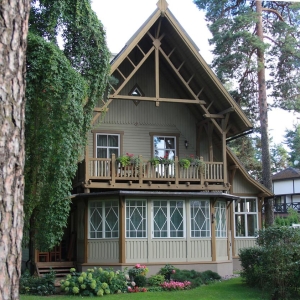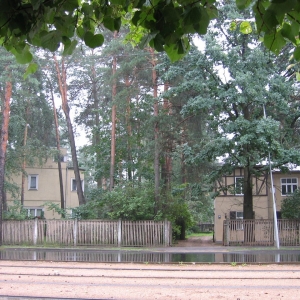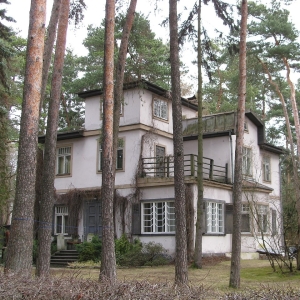
Mežaparks
Riga, Latvia
One of the first garden cities was situated in Latvia, then part of the Russian Empire.
| Garden City Type: | Mixed (housing association / municipality / other) |
| Country: | Latvia |
| City: | Riga |
| Years of construction: |
1902 Start construction
|
| Initiator/client: | Riga City Council |
| Architect or related: |
Adolf Agte Adolf Agte (German: Gustav Adolf Agthe ; Russian: Адольф Христофорович Агте. 2 November 1850 - 22 June 1906) was an engineer of German-Baltic origin. He was the chief engineer of Riga from 1887 to 1899, the head of the Riga Street Railways joint-stock company from 1899 to 1906, and the founder of the Mežaparks construction district. Georg |
| Heritage status: | No |
| General condition of Garden City: | Good condition |
General description
Mežaparks ('Ķēniņu mežs'; literally translated as ‘forest park’) is a neighbourhood in the Northern District of Riga, the capital of Latvia. It consists of a residential area to the south and a large urban park to the north with the same name. In 1901 it became the first neighborhood in the Russian Empire (of which Latvia was a part) to use the principles of the garden city movement – albeit primarily aimed at more wealthy inhabitants – and can therefore be seen as one of the world's first garden cities.
At the end of the 19th century, the principal Riga urban planner Gustavs Ādolfs Agte and landscape architect Georg Kuphaldt developed plans to develop the forest and dune territory of Ķēniņu mežs into a family park for recreation and entertainment. At this time the garden city movement also took root in Europe. Kuphaldt's plan was to create a park – taking Germany's and the United Kingdom's parks as examples – while the street layout would preserve the existing trees and dunes.
In 1900, Riga's government reviewed Kuphaldt's proposed project and decided to develop the Ķēniņu mežs area based on this vision. In 1901, to celebrate Riga's 700 anniversary, Riga City Council officially designated the area to be used half as a recreational location, and half for the construction of villas and summer houses.
Riga City Council funded the development with 500,000 Rubles to construct roads, a tram line, cycleways and bridleways. All construction work in Mežaparks had to be executed in
Architecture / Urban planning
By the start of World War I more than 110 buildings were constructed in Mežaparks. Almost all are typical examples of Art Nouveau, predominantly reflecting language of German “Heimatstil”. Nearly 50 buildings were designed by architect Gerhard von Tiesenhausen (1878–1917), who also worked out a detailed project for housing in the area of the streets Stokholmas iela and Visbijas prospekts. Most of the buildings in this area were single family houses, but a number were semi-detached houses. Their layouts are quite similar, but exterior architecture differs from house to house.
World War I stopped all construction, but it was continued from the second half of the 1920s onwards. The predominant style was Functionalism and the Modern Movement. A popular type of building constructed in the interwar period was a house with two separate apartments: one on the ground floor and the other one on the upper floor.
Sources
- Website URL
- Website URL






